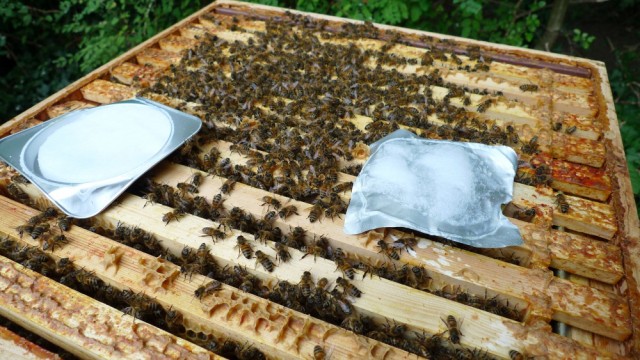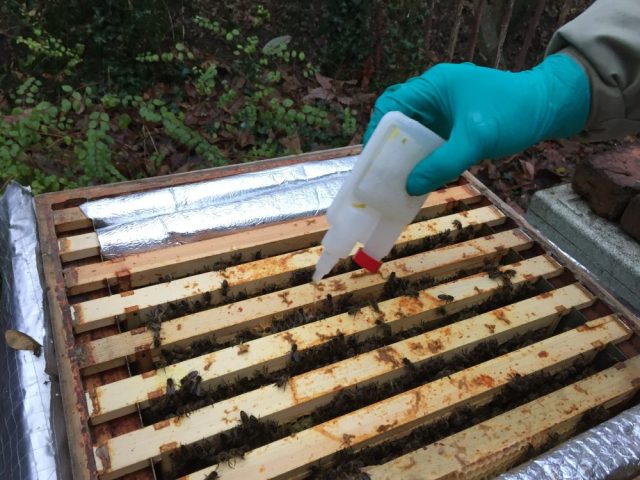I enjoyed Bee Health Day at the weekend – it’s an annual day run by the two Cornwall Beekeeping Associations (CBKA and WBKA) and the National Bee Unit Bee Inspectors. There are talks on keeping healthy bees, varroa and the Asian hornet as well as a practical apiary session and the chance to look at some diseased foulbrood combs up close. We were at the University of Exeter’s Penryn campus, which has a team of talented bee researchers led by Professor Juliet Osbourne and some incredibly beautiful flower displays. Here’s my notes from the day.
Bee health introduction
David, one of Devon’s Bee inspectors, gave us a quick intro into how to keep healthy bees. He reminded us that beekeepers are usually the number one culprit for spreading disease. You should:
- Wash your suit and hive tools with washing soda between each apiary visit
- Take a bucket with washing soda solution to the apiary and wash your tools in it between inspecting different hives
- Use disposable gloves – or Marigolds which can be washed in washing soda
- Avoid swapping frames between apiaries. He told us about a commercial beekeeper who extracted honey from hives and then gave the frames back to hives in different apiaries to clean up. The beekeeper got disease in every single hive. Mark your super frames and give them back to the same colony to clean up after extracting. Don’t leave super frames out in the open for bees to clean up.
- Aim to change your brood frames every 1-3 years. The inspectors have quite different views between them about how to do this. David greatly favours shook-swarming whereas one of the Cornish inspectors, Eric, dislikes shook-swarming. Eric gets his bees to draw out a brood box worth of brood frames each spring (with a queen excluder underneath so no brood is laid in it) and then distributes these between colonies to gradually replace a few frames each year.
- Twice a year inspect the brood combs solely for disease, rather than focusing on the usual things like whether the queen is laying or looking for queen cells etc.

Inspect brood comb regularly for brood disease. Courtesy The Food and Environment Research Agency (Fera), Crown Copyright.
Varroa workshop
Something called something like ‘Parasitic mite syndrome’, which is probably spread by varroa, is a problem at the moment. The symptoms are:
- Brood dying in capped cells
- Colony breaking down (because it’s struggling to produce healthy new bees)
I’ve written more about this in the practical apiary notes underneath.
The inspectors also mentioned that they’re also seeing a lot of Chronic Bee Paralysis Virus (CBPV) this year. The rainy weather may be behind this as when bees are cooped up inside their hive for longer periods than usual hairs are broken from their cuticles, allowing CBPV to spread from diseased bees to healthy bees in the exposed gaps.
Open mesh floors
I was interested to hear about a paper by Harris & Harbo (2004) – ‘Effect of screen floors on populations of honey bees and parasitic mites‘ which found that 0pen mesh floors (or open screen floors as they’re called in the US) cause adult varroa mites to stay on the adult bees longer, so they reproduce less regularly inside the brood cells. It’s not known why this is. However, open mesh floors are definitely A Good Thing when it comes to keeping mite levels down – every little helps.
MAQs
This was mentioned as the only authorised treatment in this country which can be used with honey supers on. The inspector running the varroa workshop asked if anyone had used it – one person said “Yes… never again”.
The inspector told us that he’d been called out this year to a beekeeper who used MAQs in March on his 12 colonies – 9 out of the 12 queens failed afterwards. He suspected too much treatment had been used. With MAQs the instructions must be followed to the letter as it’s very powerful stuff.
Thymol treatment
The inspector recommended rotating thymol treatments each year, even though there’s less chance of resistance with thymol as it attacks varroa mites in a number of different ways.
He’s a fan of Apiguard (as am I). The queen will go off lay while you treat with Apiguard, but this can be seen as an advantage in reducing mite numbers.
An audience member commented that he had more success with Apiguard in his double brood box hives when he put the trays between the two brood boxes rather than at the top. He didn’t use an eke, just put the tray under the brood frame bee space.
Oxalic acid
Someone asked how oxalic acid works – how does it kill mites? The answer was that we don’t know how it works yet, just that it does! Even the manufacturers of oxalic acid based treatments don’t know at the moment. There are various theories such as that the acid burns the mouthparts of the mites, causing them to fall off the adult bees, but nothing has been conclusively proven yet.
When trickling you need to keep the mixture warm to avoid chilling the bees, so the inspector uses a cool bag with a hot water bottle in to keep it warm. He commented that the HMF levels in pre-mixed treatment do build up and he wondered whether the HMF levels in the old pre-mixed trickles (which Thornes and other suppliers sold a few years ago) must have been quite toxic to the bees. Only make up the oxalic acid mixture just before you intend to use it.
PolyVar Yellow
I hadn’t heard of this before, but PolyVar yellow is a plastic mouse guard which gives the bees a flumethrine treatment as they squeeze through it. Shouldn’t be left on longer than nine weeks and not while honey supers are on. There were some concerns that it might knock pollen off but this doesn’t appear to happen.
Apiary inspection
We had the privilege of watching one of the inspectors look inside a hive belonging to the University of Exeter – I think I was in Eric James’ group.
Miraculously, it wasn’t raining!! It was even warm enough to sit outside without coats on (not a given in a Cornish summer).
The hive Eric inspected was struggling. It had two supers with plenty of honey and bees in them. And yet… inside the brood box the bees were only on about four frames. They had been shook-swarmed in May due to disease and seemed not to have built up again since (perhaps not surprising after a month of rain). Judging by the smell of thymol they’d also been treated for varroa with a thymol-based treatment, which may have knocked them back too.
Eric opened up some of the brood and showed us dead bees within apparently healthy looking capped brood cells which hadn’t hatched. He said the inspectors had some disagreement between them over what this was being caused by. David, the Devon bee inspector, would call it the Parasitic mite virus mentioned earlier, whereas he thought it was something new and not named yet.
Whatever it is, it’s being discovered in hives across the country. They are at a loss on how to treat it – getting the bees on new comb doesn’t seem to help. It may be transmitted by the queen or in the sperm of the drones. Some of the brood will be healthy and hatch, whereas there will be patches where the brood doesn’t and the bees will be dead inside the cells. Sometimes you will see rough perforated cappings where the bees have started opening up the cappings to try to remove the dead larvae.
After the apiary was lunch. We had been warned to bring our own packed lunch, but in the rush of leaving the house with a toddler I’d only packed a tiny croissant. “No problem”, I thought, “I’ll go to the campus shop”. I had walked past this on the way and seen a sign which said it opened at 10am on Saturdays. It was about a ten minute walk back to the shop… which was in darkness. It was then that I saw another sign underneath which said the shop was now closed on weekends. I walked to another far flung part of the campus and asked the reception staff there if there was any food about, but they told me there was none at all for sale anywhere on campus and even the one vending machine was broken. It’s a weakness of mine that I don’t function well when I’m hungry, so at this point I gave up and got the train home just so I could get some food! Unfortunately this meant I missed the diseased combs and Asian hornet workshops – next year I will make sure to pack an extra big packed lunch.



So, interesting read . . . except I’m now even less likely to get into beekeeping . . . even though I always travel with plenty of food wherever we travel anywhere.
LikeLike
I have long given up any hope that you will take up beekeeping 🙂 But I will take your dedication to travelling with food at all times as an inspirational example.
LikeLike
Well, I’m easily scared by anything that requires dedication and making an effort.
Eating, on the other hand, offers many rewards for very little effort . . . unless one has to cook one’s own food.
LikeLike
Thank you for keeping us updated. You are so fortunate to be able to attend these sessions with such well informed presenters. The disease front sounds rather frightening. We used Apiguard last year. Amelia
LikeLike
I am very lucky, it’s always a great day. Similar days are held around the country so I’ve been to the London ones before too. Apiguard is a favourite of mine which I must admit I often repeat annually as it’s so easy.
LikeLike
Emily, can you expand on the shook swarming part? Why did Eric dislike the ss method of comb renewal?
LikeLike
Hi – shook swarming is one of those things that can really split opinions and be a bit controversial. From what I gathered he felt it can be difficult for a colony to recover from unless it’s a strong colony. However in some situations (like if EFB is found) he does recommend it.
I did shook swarming a few times in London and always found my colonies had filled out their brood box within 2-3 weeks. After all bees are built to be able to build comb fast in the event of a swarm. You need to feed sugar syrup to help them along. I never shook swarmed a weak colony though.
With my Cornish bees I’m planning to do Bailey comb changes instead – mainly because these bees can be really grumpy and I don’t fancy shook swarming mardy bees!
LikeLike
Sounds interesting. Uni Exeter (Penryn) get negative points for the lack of food. I sympathise as I also dont function on no food! In my experience the main Exeter campus is well provided for even at the weekend, but that doesnt help you.
LikeLike
I’m glad to hear that at least the main Exeter campus has some food about! The lady on reception told me she had also been caught out so was stuck with no lunch.
LikeLike
Thank you very much for sharing these tips. They are really helpful.
LikeLiked by 1 person